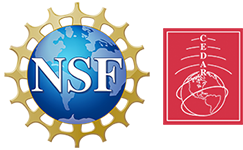2025 Workshop: Current circuit in MIT system
Toshi Nishimura toshi16@bu.edu
GEM FG leads: Doga Oztuerk dsozturk@alaska.edu & Dong Lin ldong@ucar.edu
Shasha Zou shashaz@umich.edu
Patrick Alken <patrick.alken@colorado.edu>;
Karl Laundal Karl.Laundal@uib.no
Jesper Gjerloev W. Jesper.Gjerloev@jhuapl.edu
This session solicits contributions regarding the ionospheric current system, its interaction with the ionospheric/thermospheric state variables, and its connection with the magnetospheric currents. The session welcomes any observations, models, and their combinations, in both local and global aspects of the currents including interhemispheric asymmetries. We aim to facilitate the exchange of knowledge between the GEM and CEDAR communities across different latitude regions and geophysical conditions.
Zoom information at the end of the Agenda
The 2 Scene setting presentations are 15 min inc. follow-up questions
All other presentations are 10 min inc. questions
1:30-1:35 Welcome, Introduction, Goals
1:35-1:50 Scene setting talk by Chigo Ngwira "Magnetosphere-Ionosphere Currents and Their Connection to dB/dt on the Ground"
1:50-2:05 Scene setting talk by Brian Harding "Ionospheric currents at low latitudes: Perspectives from ICON"
2:05-2:15 Sneha Yadav (presented by Larry Lyons) “Tail flow bursts: Critical to substorm current edge/auroral electrojet and R2 shielding currents”.
2:15-2:25 Mark Engebretson "Mesoscale ionospheric structures and very large geomagnetic disturbances at high latitudes."
2:25-2:35 Haonan Wu "A new global ionospheric dynamo solver: coupled ionosphere-thermosphere model studies of major storms"
2:35-2:45 Yu Hong “Impacts of Neutral Wind-induced Currents on Geomagnetic Disturbances and Magnetospheric Dynamics During the May 2024 Gannon Storm”.
2:45-2:55 Mike Hartinger "Revealing Interhemispheric Asymmetries in Mesoscale Currents with Ground-based Magnetometers"
2:55-3:05 Yen-Jung (Joanne) Wu ICON/Swarm Current "Validation of Ohm’s Law in the Ionosphere Using ICON and Swarm Data"
3:05-3:15 Yunbo Liu “Seasonal and Day-to-Day Variability of Ionospheric Current Structures: Modulation by Lower Atmospheric Forcing and Geomagnetic Configuration.”
3:15 – 3:30 Discussion
Join Zoom Meeting
https://cuboulder.zoom.us/j/97863806055
Meeting ID: 978 6380 6055
---
One tap mobile
+17193594580,,97863806055# US
+12532050468,,97863806055# US
--
Dial by your location
• +1 719 359 4580 US
• +1 253 205 0468 US
• +1 253 215 8782 US (Tacoma)
• +1 346 248 7799 US (Houston)
• +1 669 444 9171 US
• +1 669 900 6833 US (San Jose)
• +1 564 217 2000 US
• +1 646 558 8656 US (New York)
• +1 646 931 3860 US
• +1 689 278 1000 US
• +1 301 715 8592 US (Washington DC)
• +1 305 224 1968 US
• +1 309 205 3325 US
• +1 312 626 6799 US (Chicago)
• +1 360 209 5623 US
• +1 386 347 5053 US
• +1 507 473 4847 US
Meeting ID: 978 6380 6055
Find your local number: https://cuboulder.zoom.us/u/acs8bBdzDO
---
Join by SIP
---
Join by H.323
• 144.195.19.161 (US West)
• 206.247.11.121 (US East)
Meeting ID: 978 6380 6055
Currents in the magnetosphere couple to the ionosphere, creating a dynamic interaction that varies significantly in space and time, especially during periods of strong driving from the solar wind. Ionospheric currents provide valuable information about the magnetosphere, acting as a window into these far-away regions of geospace. They also modify the state of the ionosphere and thermosphere through precipitation and heating. Understanding of the global current circuits including their interhemispheric asymmetries is identified as a priority science goal in the 2024 Heliophysics Decadal Survey.
While a simple picture of field-aligned currents from the magnetosphere closing at high latitudes through horizontal current systems exists, the reality is much more complex. These currents also extend to mid- and low-latitude regions, necessitating a more comprehensive view of the global current system.
At low and mid-latitudes, current systems are often simplified and categorized as the solar quiet (Sq) current system, characterized by a counterclockwise vortex in the northern hemisphere and a clockwise vortex in the southern hemisphere connected by interhemispheric field-aligned current, along with an equatorial electrojet during the daytime. However, the 3D structure of this ionospheric current system is intricate and depends on various factors such as local and global ionospheric conductivities, wind dynamo forcing, and ionospheric and magnetospheric current sources. These complexities are not fully understood, particularly during periods of strong changes in forcing, making the current flow challenging yet crucial to comprehend.
Measuring the currents directly is difficult, but they are often inferred from magnetic perturbations observed at the ground or at low Earth orbit (LEO) altitudes. Rocket experiments that briefly enter the ionosphere provide a more detailed but local picture of the interplay between forcing and response. Ground-based observational networks and numerical simulations have presented global current distribution and evolution. These currents play a significant role in the energetics at mid and high latitudes through energetic precipitating particles, ion-neutral coupling, momentum exchange, and the ionospheric electrodynamo.
Magnetospheric Sources of Particle Precipitation and Their Role on Electrodynamic Coupling of Magnetosphere-Ionosphere-Thermosphere Systems
Doga Oztuerk dsozturk@alaska.edu & Dong Lin ldong@ucar.edu
